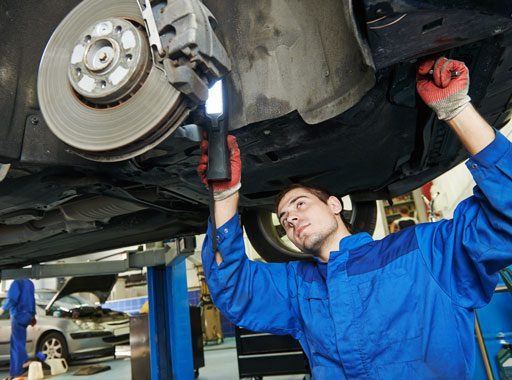Brakes
Car Brakes – Bill’s Radiator and Muffler: Understanding the Different Types and How They Work

Brakes are a crucial component of any vehicle, playing a pivotal role in ensuring your safety on the road. In this article, we will explore the various types of car brakes available and how they function. By the end of this comprehensive guide, you’ll have a clear understanding of the pros and cons of different car brake systems and how to maintain them.
Types of Brakes
- Service Brakes: Service brakes are the primary brakes used for slowing down or stopping a vehicle. They operate by applying pressure on brake levers, which then engage the braking system.
- Parking Brakes: Parking brakes are designed to prevent a vehicle from moving when it’s not in gear. They are crucial for keeping your car stationary when parked.
- Emergency Brakes: Emergency brakes provide maximum stopping power by gripping all four tires simultaneously. They hold particular significance during moments of crisis.
- Drum Brakes: Drum brakes are commonly found on trucks and heavy-duty vehicles due to their cost-effectiveness. They work by using friction to slow down and stop the wheel, with brake shoes located inside the wheel hub.
Different Brake Types: Drum, Disc, and Tandem
- Drum Brakes: Drum brakes, as mentioned earlier, are equipped with brake shoes inside the wheel hub. These shoes are pressed against the drum, generating friction to slow down and eventually stop the wheel.
- Disc Brakes: Disc brakes use hydraulic pressure to engage calipers equipped with metal discs. When pressure is applied, these discs squeeze together, creating friction to slow down or stop the wheel.
- Tandem Brakes: Although not commonly used in cars, tandem brakes are sometimes found in heavy trucks and buses. They play a vital role in ensuring these large vehicles can come to a complete stop effectively.
How Brakes Work
Understanding how brakes function is key to comprehending their importance:
Brakes work by converting the kinetic energy of a moving vehicle into heat through friction. When you press on the brake pedal, pads grip the car’s rotors (circular metal plates at the end of each axle), creating friction and generating heat. This process eventually leads to your car slowing down or coming to a halt. The duration and force with which you press the car brake pedal determine the degree of deceleration.
The car brake system is an integral part of your car’s safety system, as it regulates the rotation of the wheels. When you press the brake pedal, it transmits a signal to engage the brake system, releasing hydraulic pressure on the brake discs.
Service Brakes
How to Maintain Your Brake System
Proper maintenance of your brake system is essential for ensuring the safety of your vehicle. Here’s how you can keep your car brakes in excellent condition:
- Regularly check the fluid levels to ensure they are at the right level.
- Examine the brake pads to check for signs of deterioration and swap them out if needed.
- Consider annual or biennial tune-ups to ensure all components are functioning optimally.
- Consult a professional immediately if you notice any issues with your car brakes.
Brake systems comprise several components that must work in harmony for effective braking. Even a single worn or defective component can affect the overall performance of your car brakes. Thankfully, maintaining your brakes is relatively simple and involves routine checks, proper inflation, and occasional lubrication. By following these steps, your brake system will remain in good working condition for years to come.
Conclusion
In conclusion, car brakes are an indispensable safety feature in any vehicle. They come in various types, from hydraulic to air-cooled, and it’s crucial to choose the right one based on your budget and braking system requirements. Regular maintenance and care for your car brakes are essential to ensure they function optimally and provide the stopping power you need to stay safe on the road.
FAQs
- What are the most common types of brakes used in passenger cars? The most common types of car brakes in passenger cars are disc brakes and drum brakes.
- Why is regular maintenance of brake systems essential? Regular maintenance is vital to ensure that all brake components are in good working condition, as any defects can compromise safety.
- Can I perform brake maintenance myself, or should I consult a professional? While basic checks like fluid levels can be done by car owners, it’s recommended to consult a professional for more complex maintenance and repairs.
- What is the role of the emergency brake in a vehicle? The emergency brake provides maximum stopping power and is crucial in emergency situations where immediate braking is necessary.
- How do I choose the right type of brake system for my vehicle? Choosing the right brake system depends on your budget and the specific requirements of your vehicle. Seek advice from an expert to ensure you make a well-informed choice.
Let our certified mechanics install your new car brakes today. Call Bill’s Radiator and Muffler in Plano and the surrounding areas at (972) 422-1130 or Contact Us for all your brake needs.
